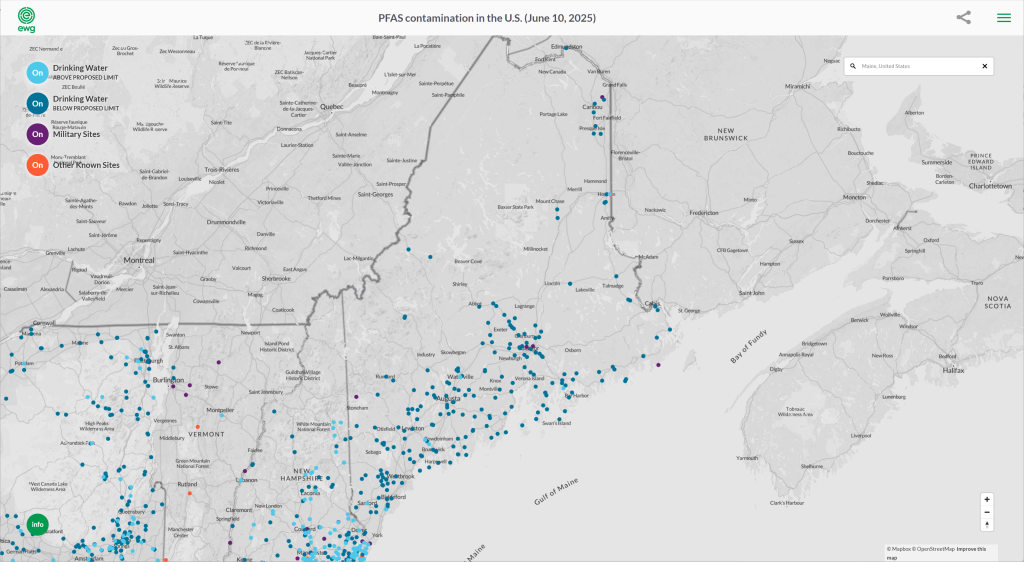PFAS in Maine
- Last updated: July 16, 2025
-
Contributor: nicky

I first learned about PFAS in Maine when contamination issues surfaced on Maine farms fertilized with wastewater sludge in 2016. Often called “forever chemicals,” PFAS (per- and polyfluoroalkyl substances) are resistant to degradation and remain in the environment for decades. I grew concerned as state testing revealed that Maine’s soil, water, and even certain foods carried traces of these persistent chemicals, posing potential health risks to individuals and communities.
Developed as early as the 1940s, PFAS have been widely used in products like non-stick cookware, water-resistant clothing, firefighting foam, and stain-repellent carpets. Thanks to their durability, PFAS do not break down easily, and exposure to them has been linked to health issues like immunity suppression, reproductive concerns, and cancers. As the seriousness of PFAS contamination became more evident, Maine spearheaded significant legislation to restrict their use and address pollution. Over 100 farms saw contamination from fertilizer sludge, prompting new laws by 2021 that banned PFAS in most products, with limited exceptions for essential items.
By 2023, the Maine Attorney General filed lawsuits against PFAS manufacturers DuPont and 3M, among others, to offset the costs of cleanup, investigation, and potential health damage. Research found that removing PFAS from municipal wastewater in Maine might cost up to USD 18 million per pound, posing a heavy financial burden on treatment facilities. Through it all, I have watched residents, regulators, and health experts weigh the dangers of PFAS with the costs and complexities of cleanup. In this article, I will highlight what PFAS are, why they matter, where contamination has occurred in Maine, and how you can determine if you qualify for a PFAS lawsuit. I will also share how Legal Claim Assistant can support those affected by these chemicals.
What are PFAS and why are they dangerous?
PFAS are a class of man-made chemicals used for their resistance to heat, water, and oil. They include compounds like PFOA, PFOS, and PFNA. Historically, industries valued PFAS for creating slick, water-repellent, or stain-resistant surfaces. Over the decades, however, these same traits make PFAS persistent in the environment.
I have seen that PFAS are dangerous mainly because they:
- Do not break down under normal environmental conditions.
- Accumulate in living organisms, including humans, over time.
- Are linked to health problems like immune system suppression, hormonal disruptions, fertility issues, and some cancers.
When I researched Maine’s environmental health records, I found repeated warnings from agencies, including the Environmental Protection Agency (EPA). Officials cited PFAS in the blood of 97% of Americans, according to the Centers for Disease Control and Prevention. These substances can travel up the food chain, and once they enter the bloodstream, they tend to stay for years. Over time, the accumulation raises concerns about long-term low-level exposure and its impact on human health.
Where are PFAS found in Maine?
PFAS contamination in Maine extends across multiple sectors. Based on state reports, PFAS have been detected in:
- Agricultural lands. For decades, farmers used sludge-derived fertilizer that contained PFAS. As a result, over 100 farms across the state discovered PFAS-laden soil.
- Municipal wastewater sludge. Because PFAS do not degrade quickly, sludge from wastewater treatment plants can carry these chemicals. Maine has since passed legislation restricting the use of sludge on agricultural fields if it contains PFAS above legal thresholds.
- Public and private wells. One of the most serious cases involves Fairfield, where some well water readings skyrocketed to levels nearly 1,000 times higher than Maine’s acceptable limits, according to state testing. The contamination forced some residents to rely on bottled water.
- Everyday household and industrial products. Historically, PFAS ended up in household goods like carpets or non-stick pans sold in Maine. As of 2021, Maine laws began phasing out PFAS for most consumer products, with certain exemptions.
I have found references to the Maine Department of Environmental Protection working with academic institutions and private industries to monitor PFAS in wastewater, drinking water, and soil. The ultimate goal is to better gauge the extent of contamination and slow its spread.
PFAS in Maine’s drinking water
Drinking water is one of the most concerning paths of exposure. Between the private wells of rural homesteads and the municipal systems that supply entire towns, Maine faces a challenging task. The EPA recently set Maximum Contaminant Levels (MCLs) for several PFAS, which Maine will adopt or potentially exceed in strictness.
Some of the key developments:
- The EPA’s Council on PFAS recommended that water systems install specialized filters like granular activated carbon (GAC) or ion exchange (IX) resin to trap PFAS.
- Maine spurred interim drinking water standards in June 2021, which demanded action when combined PFOA and PFOS levels exceeded 70 parts per trillion (ppt).
- A new Rhode Island–style approach to collaborative projects may emerge, as neighboring states like pfas vermont and pfas new hampshire face similar contamination issues.
From what I have observed, local utilities have begun testing for PFAS, and many property owners are installing home filtration systems. Public health agencies recommend ongoing monitoring to make sure filters are functioning properly. The financial burden, however, remains an obstacle. Maine communities often need state or federal grants to upgrade their infrastructure. But for many residents, these steps are worth it if they keep harmful contaminants out of the family tap.
PFAS in Maine’s soil and agriculture
Since PFAS can survive through wastewater treatment, land application of contaminated sludge introduced PFAS to farmland soil. With repeated use of this sludge, PFAS gradually built up in the soil and then transferred into crops or livestock. In Maine, a notable incident involved agricultural land in Fairfield, where PFAS pollution made some fields unusable. Testing revealed these chemicals in the soil, potentially jeopardizing local food supplies.
Farmers have reported hardships in marketing their goods, as consumers now question the safety of crops grown on land that has ever had PFAS exposure. In response, Maine passed legislation prohibiting the land application of tainted sludge, forcing wastewater treatment plants to assume greater responsibility for disposal. Some of the plants also face higher operating costs, as specialized hauling and incineration might be required to destroy PFAS-laden waste.
I have seen first-hand accounts from farmers who expressed concern over the viability of their livelihoods. Many are anxious about the uncertainty of future standards and the high cost of verifying their farms as PFAS-free through rigorous testing. Despite these challenges, ongoing research aims to find methods to recondition soils or remove PFAS from organic matter, but so far, there is no universal solution.
Health effects of PFAS exposure
Most of the scientific community agrees that PFAS exposure can harm human health, though the degree of toxicity can vary by chemical type, concentration, and duration. Research funded by the National Institute of Environmental Health Sciences has connected certain PFAS to an increased risk of:
- Changes in liver enzymes
- Thyroid disorders
- Decreased antibody response
- Developmental delays in infants and children
- Cancers such as kidney, testicular, and possibly others
Personally, I have followed case studies from Fairfield, Maine, where families with extraordinarily high PFAS levels in their private wells described symptoms ranging from chronic fatigue to serious illnesses. While individual cases can be influenced by numerous factors, medical experts cite multiple plausible disease pathways linked to PFAS’s ability to disrupt hormones, immune responses, and cellular DNA repair processes.
Federal agencies, including the EPA, have acknowledged these risks by setting health advisories and working with states to track and reduce PFAS exposure. However, many scientists believe that hundreds of PFAS variants remain unexamined. They warn that each compound may behave differently in the body, complicating risk assessments and regulation strategies.
Cancer and illness linked to PFAS in Maine
State health officials and local researchers have examined PFAS-related illnesses in Maine. While I am careful about correlating PFAS with specific health outcomes, multiple studies and lawsuits point to increased rates of certain types of cancers and immune disorders in communities with prolonged PFAS exposure.
Kidney cancer
Kidney cancer has emerged as a concern among residents in high-exposure areas. Doctors note that PFAS may disrupt kidney function over time. Although research is ongoing, evidence from national studies and health surveys supports possible connections between PFAS and greater incidence of kidney-related disease. I have spoken with people in Fairfield who believe their chronic kidney issues could be related to PFAS, though they await confirmation from medical experts.
Testicular cancer
Testicular cancer has been documented as one of the potential outcomes associated with PFAS exposure. In Maine communities studied for PFAS contamination, a few individuals with this rare disease have questioned whether industrial releases, sludge applications, or polluted water sources may have contributed to their condition. While it is difficult to isolate PFAS as a sole cause, testicular cancer in populations with elevated PFAS levels is a recurring research focus.
Testicular cancer
Additional cases follow a similar pattern, with individuals reporting testicular masses after living near areas with known PFAS contamination. Some have joined class-action lawsuits or pursued personal injury claims, citing PFAS-laden water as a potential factor in their diagnoses. Health departments often call for more comprehensive data to strengthen the understanding of any link between PFAS and testicular cancer.
Testicular cancer
The repeated attention on testicular cancer underscores the ongoing uncertainty surrounding PFAS exposure and male reproductive health. Testicular cancer remains relatively uncommon, so even small cluster increases prompt concern and further investigation. Maine’s Department of Health and Human Services is encouraging broader population-level studies to establish any statistical correlations that might lead to stronger protections or public health interventions.
How is Maine responding to the PFAS crisis?
Maine has taken multiple steps to address PFAS contamination. In 2021, the state passed groundbreaking legislation banning PFAS in most consumer products, with exceptions only for items deemed truly essential for health and safety. The law initially set a comprehensive ban by 2030, but reporting and compliance delays have led to phased deadlines. Manufacturers must now disclose PFAS usage, and many companies have moved to eliminate intentionally added PFAS from their supply chains.
On top of that, Maine banned the land application of sludge proven to be contaminated with PFAS, effectively preventing further soil exposure. The Department of Environmental Protection is coordinating with local wastewater treatment plants, encouraging them to invest in specialized disposal methods, such as incineration, which meets certain emerging disposal guidelines set by the Department of Defense.
I have kept track of lawsuits as well. In March 2023, Maine’s Attorney General sued PFAS manufacturers DuPont, 3M, and others, seeking to recover costs of treating, cleaning, and monitoring PFAS pollution. These legal actions reflect a growing trend nationwide, where states hold chemical producers accountable for potential harm. Meanwhile, the EPA is also considering designating PFOS and PFOA as hazardous substances under the Comprehensive Environmental Response, Compensation, and Liability Act (CERCLA), which could affect cleanup protocols statewide.
Can you test your water or soil for PFAS?
Yes. I have found that many laboratories in or near Maine now offer PFAS testing services. If you suspect your well water or soil is contaminated, you can:
- Contact a state-certified lab for collection kits and instructions.
- Follow proper sampling procedures, ensuring sample containers are not exposed to Teflon or any PFAS-based products.
- Submit your samples to the lab for analysis.
- Review results with local health officials, who can help interpret any findings and recommend next steps.
Filtration systems with GAC or ion exchange media can reduce PFAS levels significantly, but frequent maintenance and filter replacements are critical. When dealing with soil, tests may be more complex, especially if farmland has a long history of commercial sludge application. In these scenarios, experts may recommend not planting crops until further testing confirms acceptable PFAS levels.
Do you qualify for a PFAS lawsuit in Maine?
If you or your property has been affected by PFAS contamination, you may have grounds for a legal claim. I often suggest seeking advice if:
- You have diagnosed health conditions possibly linked to PFAS, such as certain cancers or thyroid disorders.
- Your private well tested above Maine’s PFAS thresholds for drinking water.
- Your farmland or property has lost value or faced restrictions due to PFAS levels.
- You incurred extra costs, such as the installation of water filters or equipment upgrades, specifically to handle PFAS.
Industries responsible for releasing or manufacturing these chemicals can be held accountable in some cases. The lawsuits often cite distorted marketing practices or negligence in handling hazardous byproducts. Not all PFAS claims are identical, though. Eligibility hinges on factors like medical evidence, documented contamination levels, and the statute of limitations within Maine’s relevant laws. If you are unsure, consultation with a legal professional might clarify your options.
How Legal Claim Assistant can help
When I realized PFAS contamination can be daunting, I turned to resources like Legal Claim Assistant to understand my rights. Legal Claim Assistant helps individuals identify whether their situation warrants a claim. They connect potential plaintiffs with lawyers in the PFAS field who can offer a free case review.
They can also prepare your documentation and guide you toward:
- Filing a claim against liable parties, including PFAS manufacturers.
- Navigating class-action or mass-tort opportunities.
- Calculating damages related to medical bills, property devaluation, or other losses.
Litigation can be complex, and PFAS claims often require scientific evidence tying chemical exposure to specific injuries. Legal Claim Assistant taps into a network of attorneys familiar with PFAS-based lawsuits, including water contamination suits and claims against large manufacturers like DuPont.
I appreciate their approach: you receive support for your questions while they evaluate eligibility. If your claim moves forward, they match you with experienced counsel who understands Maine regulations and broader federal guidelines.
Frequently asked questions (FAQ)
PFAS concentrations have been confirmed near Barksdale Air Force Base, the former England Air Force Base, and in southeast Louisiana’s drinking water. According to LDEQ data, areas around petrochemical facilities are also at risk. If you live near industrial zones or military sites, it is wise to verify local water reports.
Yes. You can hire a lab that specializes in PFAS analysis, or attend community-sponsored testing events. Prices vary depending on how many PFAS chemicals the lab can detect. Make sure to follow specific sampling instructions to avoid cross-contamination.
Many scientific studies have noted higher risks of kidney cancer, testicular cancer, liver dysfunction, thyroid disorders, and potential immune system effects. According to the National Toxicology Program, PFAS can weaken immune responses, which may make it harder for the body to fight infections.
You typically need documented proof of PFAS exposure and a related health condition recognized as PFAS-linked. An attorney will also consider whether there is a traceable source, such as a manufacturing site or a military base. For guidance, you can contact Legal Claim Assistant or a dedicated PFAS lawyer.
Get your water tested for PFAS or request local testing data.
Consult a healthcare provider for a checkup and mention possible PFAS exposure.
Speak with an environmental law attorney to explore your legal options.
Keep copies of medical records, test results, and any official advisories about PFAS.
If you suspect PFAS exposure, I recommend visiting PFAS lawsuit for a free case review and help understanding next steps. Taking timely action could protect you, your family, and your community from further harm.
Overview PFAS contamination in the USA
Here you van find the PFAS watercontamination map of the United States. Find, state by state, where water contamination has occurred due to PFAS exposure.
- PFAS in Alabama
- PFAS in Alaska
- PFAS in Arizona
- PFAS in Arkansas
- PFAS in California
- PFAS in Colorado
- PFAS in Connecticut
- PFAS in Delaware
- PFAS in Florida
- PFAS in Georgia
- PFAS in Hawaii
- PFAS in Idaho
- PFAS in Illinois
- PFAS in Indiana
- PFAS in Iowa
- PFAS in Kansas
- PFAS in Kentucky
- PFAS in Louisiana
- PFAS in Maine
- PFAS in Maryland
- PFAS in Massachusetts
- PFAS in Michigan
- PFAS in Minnesota
- PFAS in Mississippi
- PFAS in Missouri
- PFAS in Montana
- PFAS in Nebraska
- PFAS in Nevada
- PFAS in New Hampshire
- PFAS in New Jersey
- PFAS in New Mexico
- PFAS in New York
- PFAS in North Carolina
- PFAS in North Dakota
- PFAS in Ohio
- PFAS in Oklahoma
- PFAS in Oregon
- PFAS in Pennsylvania
- PFAS in Rhode Island
- PFAS in South Carolina
- PFAS in South Dakota
- PFAS in Tennessee
- PFAS in Texas
- PFAS in Utah
- PFAS in Vermont
- PFAS in Virginia
- PFAS in Washington
- PFAS in West Virginia
- PFAS in Wisconsin
- PFAS in Wyoming
Related Article

What Philips CPAP Machines Are Recalled and Why

